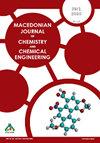Variability of the arbutin content in wild growing populations of Arctostaphylos uva-ursi (L.) Spreng from Korab Mountain, Western Balkan
IF 1.1
4区 化学
Q3 CHEMISTRY, MULTIDISCIPLINARY
Macedonian Journal of Chemistry and Chemical Engineering
Pub Date : 2021-05-11
DOI:10.20450/MJCCE.2021.2095
引用次数: 0
Abstract
Due to the presence of arbutin and hydroquinone in the bearberry plant (Arctostaphylos uva-ursi (L.) Spreng., Ericaceae), it is widely used as a urinary tract antiseptic and diuretic. The herbal substance consists of whole or cut dried leaves, and it should not contain less than 7.00% of anhydrous arbutin (Ph.Eur.10). The supply of this herbal substance in Balkan countries mainly comes from a wild plant harvested in the mountains. It is a common practice to collect the leaves during the flowering season of the plant (June-July). There is an abundance of wild growing natural populations of bearberry on Korab Mountain that represents a unique natural resource of this herbal substance for both countries, Albania and North Macedonia. The aim of the present study was to determine the arbutin content and to assess its variability in the bearberry leaves of seven wild populations from Korab Mountain. The leaves were collected monthly (May-October) during a period of 3 years (2014-2016). The HPLC assay (Ph.Eur.10) revealed that all populations have arbutin content over 7.00% (7.03-9.42%) and that the highest content of arbutin can be attained in September/October, during the phase after the fructification. Statistical analysis showed that there is significant difference between the content of arbutin in the different populations. The content was related to the altitude of the collection site and the collection month and year.西巴尔干Korab山熊果苷在野生种群中含量的变异性
由于熊果属植物中存在熊果苷和对苯二酚(Arctostaphylos uva ursi(L.)Spreng。,Ericaceae),它被广泛用作尿路防腐剂和利尿剂。草药由整片或切下的干叶组成,其无水熊果苷含量不应低于7.00%(欧洲药典第10版)。这种草药在巴尔干国家的供应主要来自山区收获的野生植物。在植物的开花季节(6月至7月)收集叶子是一种常见的做法。Korab山上有大量野生生长的自然熊果种群,这对阿尔巴尼亚和北马其顿两国来说都是这种草药的独特自然资源。本研究的目的是测定Korab山七个野生种群熊果苷的含量并评估其变异性。在3年期间(2014-2016年),每月(5月至10月)收集叶片。HPLC测定(欧洲药典10)显示,所有种群的熊果苷含量都超过7.00%(7.03-9.42%),并且在果实成熟后的9月/10月可以达到熊果苷的最高含量。统计分析表明,不同种群的熊果苷含量存在显著差异。内容与采集地点的海拔高度以及采集月份和年份有关。
本文章由计算机程序翻译,如有差异,请以英文原文为准。
求助全文
约1分钟内获得全文
求助全文
来源期刊
CiteScore
1.60
自引率
20.00%
发文量
14
审稿时长
>12 weeks
期刊介绍:
Macedonian Journal of Chemistry and Chemical Engineering (Maced. J. Chem. Chem. Eng.) is an official publication of the Society of Chemists and Technologists of Macedonia. It is a not-for-profit open acess journal published twice a year. The journal publishes original scientific papers, short communications, reviews and educational papers from all fields of chemistry, chemical engineering, food technology, biotechnology and material sciences, metallurgy and related fields. The papers published in the Journal are summarized in Chemical Abstracts.

 求助内容:
求助内容: 应助结果提醒方式:
应助结果提醒方式:


